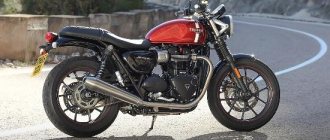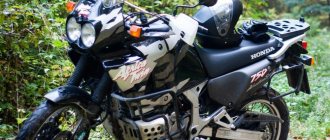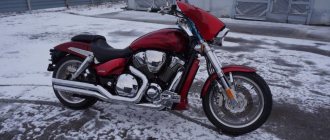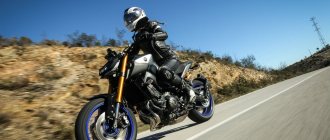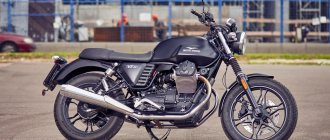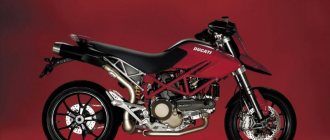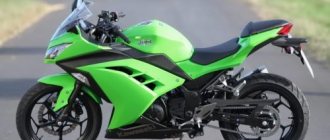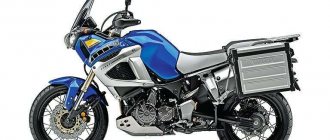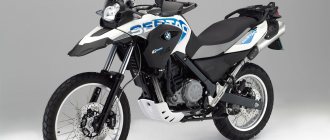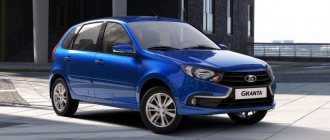Red Africa: test drive Honda Africa Twin CRF1100L (2021)
In 2021, Honda introduced completely updated flagships of the Adventure class - according to documents, practically the same motorcycle CRF1100L in Africa Twin and Adventure Sports versions; but completely different in essence. What are the key differences between the two and who would be better suited for Red Africa than Continental Conqueror?
MOTOGONKI.RU, June 1, 2021 - Indeed, Honda has created three completely different stories - the Adventure Sport of the 2018 model, the new Adventure and the Africa Twin of 2021.
“Conqueror of the Continents” - the latest generation flagship Honda Adventure Sports, packed with electronics, is now much more focused on additional road conditions (with or without asphalt). The same Adventure 2018 was a real tank, capable of ramming a car and, as if nothing had happened, on the same day make a march of one and a half thousand, cross Russia from south to north, climb mountains, reveal the secrets of quarries and return back a day later .
Honda CRF1100: Once upon a time there were two brothers, related by blood, but not in spirit...
Read more: Two plus one - all about the 2020 Honda CRF1100L
The base Africa Twin has remained in the flagship's shadow for the past four years. And so, realizing this, Honda purposefully divided the lines - according to their intended purpose.
Test drive Honda CRF1100L Africa Twin (2021)
Today, Africa Twin and Adventure Sports are not only designed for different purposes, but they also ride completely differently. At the same time, keeping all the same filling: they have exactly the same engines, set of electronics, on-board multimedia station, DCT, frame and swingarm.
What's the main difference?
On paper and if you put the motorcycles side by side, it is not visible at first glance at all.
Diagram: difference in fit and silhouette - on paper
But it’s worth touching each motorcycle individually, and then riding each one in turn, and then everything secret becomes clear.
There are three differences: landing, chassis and actually felt weight.
First, the difference in weight is felt instantly! On paper, the dry weight of the CRF1100 DL (Africa Twin with DCT) and the CRF1100 A4L ES (the top-end Adventure Sports version with DCT on Showa EERA semi-automatic suspension) differs by just 4kg. The weight of the “adventure” is added by a protective canopy, an additional rear shock absorber actuator and two control electronics units, as well as a much heavier fork, plus a 24-liter gas tank (it is itself more massive). With a full tank the difference is already more than 10 kg.
Test drive Honda CRF1100L Africa Twin (2021) and Adventure Sports (2021)
In terms of chassis and suspension, and here on paper everything seems to be the same: Honda has eliminated the difference in suspension height between the Adventure Sports and Africa Twin, and now both motorcycles have equal fork and shock absorber travel of 230/220 mm. They have the same saddle height (minimum 250 mm). But the shape of the saddle itself and the gas tank are completely different, and this completely changes the course of the game!
Even if you just roll the motorcycles around the site with your hands, you can feel how much more massive the Adventure is. Everything is affected. Even the fact that it has tubeless tires, while the Africa Twin has tube tires. On the one hand, tubeless tires are great. They are lighter in themselves, they have a different frame, which provides greater stability in corners. The compound of tubeless tires has one feature: when hot, even if it gets punctured, it can hold air for a long time while driving (the soft rubber granules expand and cover the hole). And as soon as the tubeless tire with a puncture cools down, it instantly deflates, and nothing can be done about it. But a tubeless tire can be repaired with a simple bead of glue, which makes repairs quick. And when traveling, such moments can be worth their weight in gold.
Honda CRF1100L Adventure Sports (2020) on the same, only tubeless Bridgestone Adventurecross
But tubeless tires are intended for use in tandem with cast wheels that have a monolithic design. Spokes for tubeless tires have their own design features: if the spokes on tubed wheels are installed in one row (in the center of the rim) and for this reason their diameter may be smaller, then in tubeless tires a double-row installation of spokes in the end of the rim is required, and to ensure reliability, the diameter there are more spokes installed at an angle. Spokes for tubeless tires are much more technologically advanced, however, they are more expensive and heavier than rims for tubeless tires. And it provides worse shock absorption on bumps due to twice the rigidity of the structure. The advantage is the possibility of more accurate balancing of such a wheel for driving at high speeds.
The difference in weight is felt as soon as the wheel starts to spin. Combined with the extra mass of the fork and semi-automatic shock, the Adventure Sports feels heavier throughout than the stock Africa. You won't feel it on a highway with good asphalt, but just take a dirt road, et Voila!..
Test drive Honda CRF1100L Africa Twin (2021): Vasily approves!
The ergonomics and weight distribution of the Africa Twin are designed for long standing riding. Short (“sporty”) fairing glass – so as not to get in the way. The base CRF1100L seat is tall, flat and firm. But if you are 180+ tall, then you will appreciate this simple solution!
It is assumed that the Africa Twin should be ridden not in an integral or a flip-up, but in a motocross helmet with goggles or an enduring full-face helmet with glass, such as the Shoei Tour-X. When sitting, the seating position is higher and more aggressive than on the Adventure Sports. And if you are driving on a dirt road or gravel, and there is a partner or a car ahead, then all the small stones and debris fly into your face, neck and chest.
Test drive Honda CRF1100L Africa Twin (2021): base seat - high, flat and hard
The 2020-21 Africa Twin is aimed at selfish people. It is for those who want to hit the pampas. At its core, this is a huge motocross bike that implements many of the ideas from the champion CRF450R motocross bike - geometry and concept. But this is not that lightweight enduro “four” and not at all the Honda CRF300 Rally, with which you can easily dive into any bushes.
This is a motorcycle for moving from asphalt to hard and rough off-road, but without extremes in the form of fallen trees and liquid shit along the very axles. To overcome extreme off-road conditions, it is better to ride in a group, because pulling a 230-kilogram motorcycle out of a swamp and throwing it over centuries-old trunks alone is still a pleasure. But with the Adventure Sport it’s not worth doing this at all: 70% of the motorcycle will remain there forever in the form of debris.
Test drive Honda CRF1100L Africa Twin (2021)
The work of the standard suspension on the Africa Twin is much better readable than the “sticky” Showa EERA on the Adventure. As soon as you jump off the asphalt, it immediately affects you: you stand up on the pegs and cushion with slightly bent knees, the CRF1100L jumps under you the way it wants (and the way IT needs); Very little comes into the steering wheel and shoulders, and this makes riding in a standing position seem very comfortable. You can move forward a little and apply the gas so that mincemeat can fly out from under the rear wheel of the Africa Twin on all sides - and this will not in any way affect the straightness of movement.
The Africa Twin fork easily swallows bumps with a height/depth of plus or minus 70-100 mm, as if they were not there at all, and the aggressive Bridgestone Battlax Adventurecross installed on the Africa Twin by default perfectly clings to the ground of almost any degree of hardness, even concrete! But driving on deep sand and liquid clay requires the installation of “tractor”, very grippy tires. Still, the word “Adventure” in the name of the rubber prevails.
Basic tube tires Honda Africa Twin - Bridgestone Battlax Adventurecorss
Honda Adventure Sports behaves completely differently with Showa EERA and the same Bridgestone, only tubeless. Some 2021 versions of the bikes came with METZELER Karoo Street, even more “asphalt” tires. The behavior of the electronic plug, even when switched to “Off-Road” mode, can hardly be called soft and predictable. The wheel hits an obstacle and the Showa “thinks,” and it’s not a fact that the tire will have time to catch the side... During last year’s Adventure Sports test, I got into this situation twice: not the deepest ruts suddenly became an insurmountable obstacle for the motorcycle...
...and these same ruts, a week later I was easily and gracefully flying on an Africa Twin with a conventional, “mechanical” fork and the same Bridgestone Adventurecross. The motorcycle immediately reminded me of my first acquaintance with the 2021 Honda CRF1000L and a two-week walk to the peaks of the Swiss Alps. Then, in September 2021, I did not experience a single “oh, shit!!” moment during the entire trip, although “paved roads” in the mountains end at around 2000 m even in Europe.
It's this difference that sets today's Adventure Sports apart from the Africa Twin: freedom of action on dirt and gravel and a feeling of control, even if you don't have much enduro experience on a heavy bike.
Spiers-willies
The very first feeling (on the asphalt) is that the “basic” CRF1100L seems and drives more aggressively, you want to step on the gas and play around with it. His habits are similar to a large motard. In the traction control and ABS settings there is a special mode for those who have nothing to lose - “disable all restrictions and controls” (details in the following paragraphs).
Adventure Sports allows you to easily accelerate to 215 km/h, and advanced wind protection facilitates prolonged driving at speeds above 160 km/h (for example, on European autobahns or along the M11).
Test drive Honda CRF1100L Africa Twin (2021)
In the saddle, the Africa Twin begins to “take your head off” already at 140, and when you reach 170 you need to hold on to the steering wheel very tightly. Plus, any side breeze immediately changes the level of comfort. But the maximum speed is the same - 215 km/h.
The fact that other test pilots before me mercilessly “fried” “Red Africa” for a beautiful picture (and simply for fun) was revealed by the average consumption spent during the 864 km “run-in” - 8.9 l/100 km. In general, for the CRF1000L and CRF1100L it’s just crazy! That is, the motorcycle was constantly driven faster than 160 km/h and most likely on the rear wheel, because the DCT control unit had to be reset again and run-in from scratch (the roof of the “robot” had already begun to be torn off from the merciless murder, and the reaction of the DCT control unit were not entirely adequate).
Resetting DCT after bullying other test pilots is sacred!
For comparison, during the run-in period of the Adventure Sports from scratch, the same figure for 1,400 km traveled was 5.6 l/100 km. But as soon as the odometer crossed the magic o, and the DCT and ECU automatically switched to operating mode, the engine’s potential was fully revealed. This is what I strongly recommend to others: do not spare a day or two to leisurely break in a new motorcycle with DCT, you only need 1200 km!.. And if you took it second hand, take the bike to an official dealer and rewire the DCT control unit (this will not affect the engine control unit ): then the motorcycle will learn to work FOR YOU
and
YOU
, and not those who raped him before you.
But Honda already realized in 2021 that a motorcycle like the CRF1100L with DCT would still be ungodly tormented in every possible way, so the company did everything to make its fate easier. First, there's the easy-to-control Wheelie mode.
(in the previous version, the electronics struggled with this effect with all their might).
Test drive Honda CRF1100L Africa Twin (2021)
Now, you should turn off the traction control
and reduce Wheelie Control to a minimum; when you actively open the throttle in S2 mode, the motorcycle tends to lift the front wheel up.
Another cool feature for those who need pure adrenaline is the ABS RR
– connected front circuit with disconnected rear circuit.
Constant slipping of the rear wheel (during active acceleration or braking) adds a spicy touch to the ride. When we were testing the equipment, the Moscow region literally exploded with an asphalt boom - they were removing the old one everywhere and trying to install a new one in the shortest possible time. Freshly laid asphalt is always slippery, and in the case of the Africa Twin it’s so much fun!!! Excellent grip on a slightly overloaded front-end and constant slip on the rear - with those long black lines that the tire leaves on the asphalt - wow! A kind of “Supermoto” mode is only for experienced riders, since the motorcycle still weighs a little more than 235 kg with gasoline, do not forget about it
.
Test drive Honda CRF1100L Africa Twin (2021)
The CRF1100L leans into corners easily, despite the not-so-sporty tires. It will provide a lot of fun on winding paths and switchbacks (if only you can get to them!)
Already on the first day of the test I managed to burn down two tanks. Yes, the Africa Twin has it significantly less than the Adventure Sports - 18.8 liters according to papers, but I have never managed to drain it completely, although I saw “18.5” on the column. This gasoline runs out quickly, because you always want to ride a motorcycle sharply and aggressively. And to be honest, I stopped counting consumption altogether after the 2nd fill-up.
Fully electronic instrument panel with color touchscreen and multimedia center
How does it generally drive on asphalt if you want to drive 300-400 km away from the city?
Yes, this is also the trick of the Honda Africa Twin: it allows you to go where you can accelerate well.
And in the conditions of today's urbanization, there are fewer and fewer such places near the city, and to enjoy the rides you need to travel 200-250 km before... you start enjoying the rides - without traffic and any other third-party threats, like speed cameras and trucks.
…and again, the word “sticky” comes to mind in relation to the Adventure Sport: the behavior of the CRF1100L in touring form, that is, on the freeway, is a real electric locomotive that got on the rails and went forward. Neither headwind nor side wind, nor slight unevenness on the asphalt surface will disturb the comfort and peace of the rider. The adventure's chassis is viscous and bites into the asphalt, providing it with phenomenal stability.
Test drive Honda CRF1100L Africa Twin (2021)
The Africa Twin responds to every input on the steering wheel, but also to the wind. We are not talking about hints of wobbling (it is not here, never was and never will be), but about the fact that at speeds above “140” the motorcycle can smoothly move half a meter to the side.
Total?
Usually, I sum it up here. But in the case of the three Africas, I do not have a single verdict. In terms of drive and overall overall riding fun, I'd still go with the 2018-2019 Adventure Sports: it's more in line with the concept that Honda pioneered in 1989 - a high-speed tank capable of crossing the Sahara Desert in a very short time . It requires special skill in off-road piloting, but the pleasure and capabilities of the motorcycle are amazing - absolutely all-accessible, lightweight and controllable at the same time.
Honda CRF1000L Adventure Sport (2018) - yes, this is my tank!
But the electronic components and the unified multimedia center of the Honda CRF1100L change our ideas about a motorcycle for long trips.
Is it possible to take a Honda CRF1100L Africa Twin and turn it into an Adventure Sports? Today this is a simple task. That's exactly what I would do!
Next - an exclusively personal opinion: I don’t need electronic suspensions at all (minus 200 TR); it is possible to install a comfortable saddle on the Africa Twin (it is included in the accessories, plus it is available from many aftermarket brands); It’s easy to load different types of luggage onto the Africa Twin; tall glass instead of “shorty” - even lighter. And everything else under the hood is identical for both CRF1100s.
Test drive Honda CRF1100L Africa Twin (2021): install a comfortable saddle? Easily!
The difference will still be in range due to the Adventure Sports' 6 liters of extra petrol.
This allows you to drive it 210 km in 1 hour (I repeat: that is, drive 210 km in a row at an average speed of 210 km/h). In the same case, the Africa Twin will have a power reserve of 170 km. The real difference on a long route is 30-35 km every hour. For those who travel far and fast, this means that in 10 hours Adventure Sports will travel at least 200 km further than standard Africa. In reality, this advantage will be much greater, because keeping the pace even at 160 km/h for a long time on the 2021 Africa Twin CRF1100L is exhausting.
On the other hand, with the Africa Twin you can cut across the field...
Photo: author and Dee Troy
Modifications
In parallel with the main basic version, a sports modification of the model is produced.
New for 2021 is the Honda CRF1000L Adventure Sports . Despite the different name, this is a modification of Africa. It is distinguished by longer suspension travel, a fuel tank increased to 24 liters , and an extended windshield. For a separate surcharge, you can get safety bars (with a record of their presence in the vehicle title, which, of course, will upset the traffic police inspectors).
and competitors
- Introduced in 2014 , Honda became a competitor to the Yamaha XTZ1200 Super Tenere, which entered the market in 2010 . However, the engineers of the latter considered that one competitor was not enough, releasing another Yamaha Tenere 700 2017 .
- In the same 2017, Suzuki also had a child. In addition to the V-Strom 1000 , the DL1000 V-Strom XT .
- Kawasaki introduced the Versys 1000.
Characteristics
| ENGINE | WHEELS, SUSPENSION, BRAKES | ||
| engine's type | 4-stroke, 8-valve, liquid-cooled, 270° crankpin angle, Uni-cam timing | ABS system | Adaptive, switchable dual-channel ABS system |
| Working volume | 1084 cc/cm | Front brakes | Hydraulic with two 310 mm double floating discs and radial four-piston calipers |
| Bore/Stroke | 92 mm/ 81.5 mm | Rear brakes | Hydraulic, with 256 mm disc and two-piston caliper |
| Compression ratio | 10.1:1 | Front wheel | 21M/C x MT2.15 Spoked with aluminum rim |
| Supply system | PGM-FI electronic fuel injection | Rear wheel | 18M/C x MT4.00 Spoked with aluminum rim |
| Maximum power | 75 kW at 7,500 rpm | Front tire | 90/90-21M/C 54H (with camera) |
| Torque | 105 Nm at 6250 ohm/min | Rear tire | 150/70R18M/C 70H (with camera) |
| Fuel consumption | 4.9 l/100km, 20.4km/l (with DCT 4.8l/100km, 20.8km/l) | Front suspension | Inverted telescopic cartridge fork with 230 mm of travel, 45 mm diameter stays, and preload and rebound adjustments |
| CO2 emissions | 112 g/km (with DCT 110 g/km) | Rear suspension | One-piece aluminum swingarm with progressive Pro-link characteristics with gas-filled Showa shock absorber, adjustable spring preload, rebound speed, and compression, 220 mm of travel. |
| Battery Type | 12V-6A/h Lithium-ion | ||
| TRANSMISSION | DIMENSIONS AND WEIGHT | ||
| Clutch | Slip, multi-disc, oil bath, with coil springs and auxiliary mechanism to facilitate squeezing | Curb weight | 226 kg (with DCT transmission 236 kg) |
| Tank capacity | 18.8 l | ||
| main gear | O-Ring chain | Length x Width x Height | 2334 mm x 961 mm x 1391 mm |
| Transmission | 6-speed manual (6-speed DCT) | Volume | 1043 cm3 |
| CHASSIS | Wheelbase | 1575 mm | |
| Frame type | Steel, half duplex | Seat height (standard) | From 850 to 870 mm |
| Steering column angle | 27.5° | Seat height (low) | From 825 to 845 mm |
| Wheel offset | 113 mm | Seat height (high) | From 875 to 895 mm |
Peculiarities
The ability to adjust the seat height makes the motorcycle comfortable for both tall riders and shorter riders.
Since at the last motorcycle show Honda announced the start of work on Africa for the new 2021 model year, this section is divided into 2 parts. And the first is what already assembled bikes can boast of.
This:
- RbW (Ride-by-Wire system) - electronically controlled throttles.
- ABS , complemented by the ability to switch depending on the track.
- ASC (Assist and Slipper clutch) - assistance when working with the clutch.
- HSTC (Honda Selectable Torque Control) - traction control.
The second part contains what is expected in the new version as an addition to what is already installed. It should be noted that all the features described below will be optional, with the exception of the first:
- ABS , complemented by the ability to switch over a wider range ( Onroad/Offroad ).
- DRL (Daytime Running Lights) - daytime running lights.
- Control of turn signals - a couple of seconds after the maneuver, the motorcycle can turn off the light itself. The Adventure Sports modification also promises automatic activation before a maneuver.
- Heated steering wheel grips - no comment.
- Cruise control - the ability to electronically support a given speed.
The section specifically does not include any data such as excellent maneuverability, excellent handling and driving performance . After all, this is an Africa Twin - it simply cannot be otherwise.
